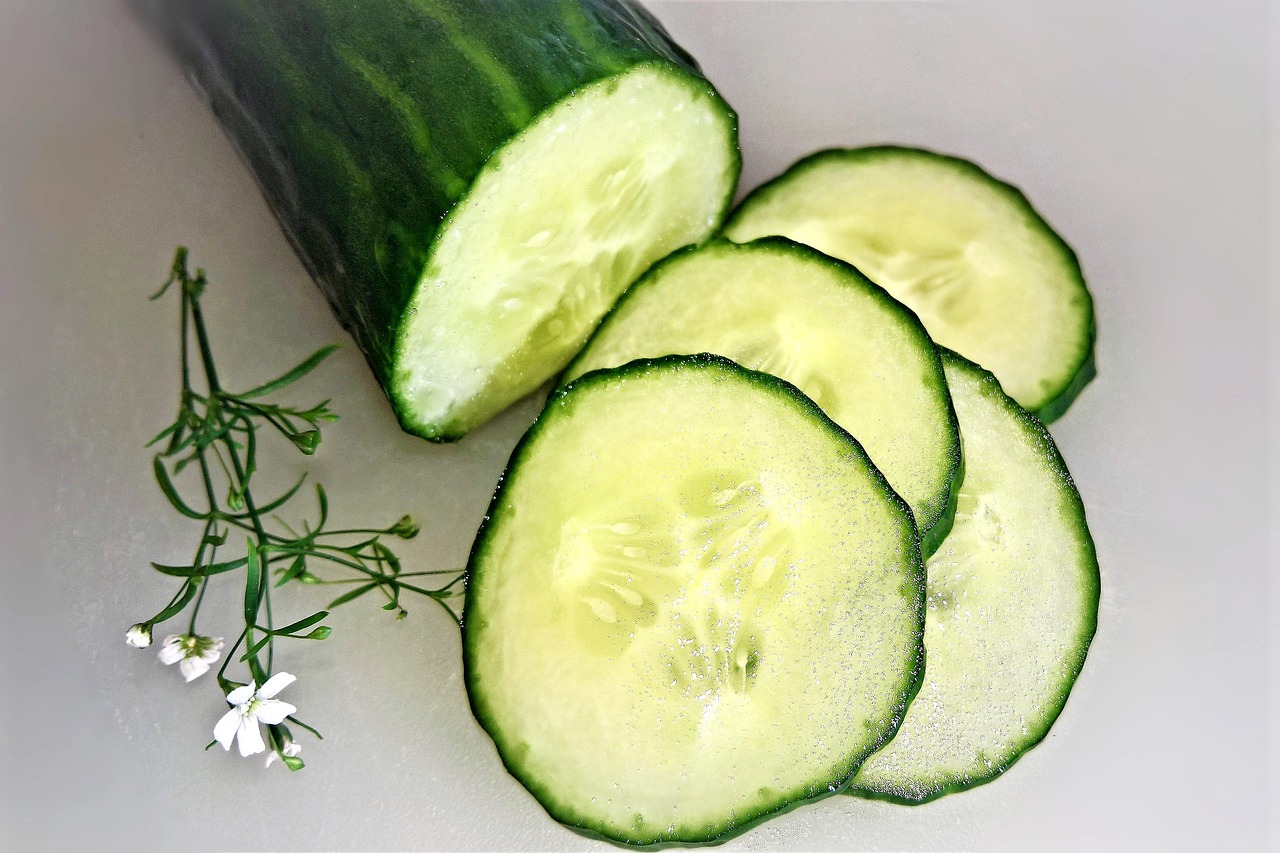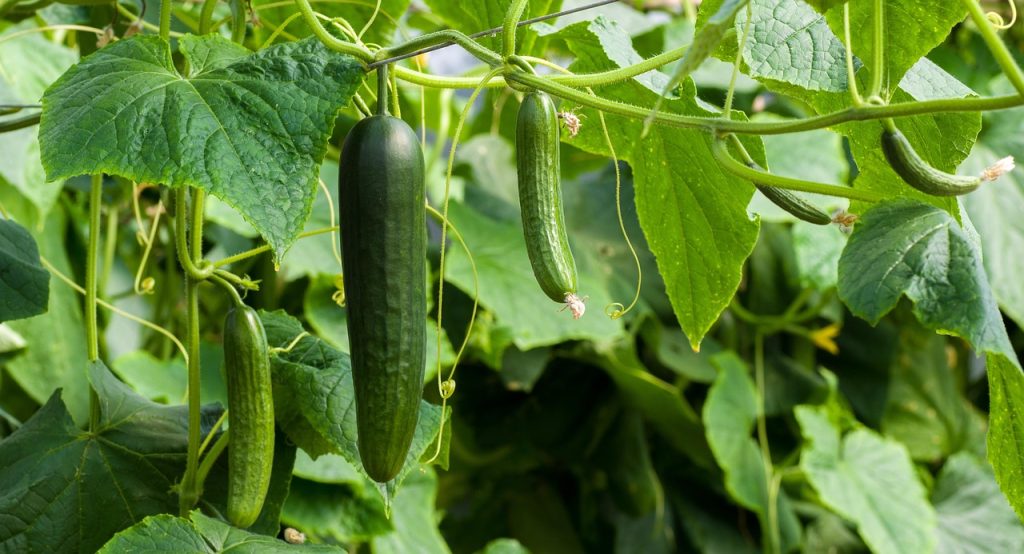Your cart is currently empty!

Cucumber – The Cooling Healer
From Kitchen Staple to Botanical Medicine Cabinet
Introduction
Familiar, refreshing and often overlooked, the garden cucumber is far more than a crisp summer snack. Behind its cool, watery bite lies a legacy of traditional use as food and medicine. From digestive relief to skin care, from hydration to parasite cleansing, cucumber has quietly served for centuries as both nourishment and remedy. Though common in kitchens, its value as original plant medicine deserves renewed recognition—honoring not just what it offers on the plate, but what it can do for the entire body. These are just a few of the medicinal benefits of cucumbers.

Botanical Profile
Garden Cucumber (Cucumis sativus)
CUCURBITACEAE (Gourd Family)
Cucumber is a warm-weather, vining annual with broad, heart-shaped leaves and yellow blossoms that give way to elongated fruits. Botanically a fruit but commonly treated as a vegetable and nearly every part of the plant holds value. It belongs to the gourd family and is related to squash, melon, and pumpkin. Native to India and cultivated for over 3,000 years, cucumber made its way to North America over many generations, eventually becoming a staple in colonial gardens. Today, it remains one of the most widely grown and consumed garden plants.
The whole fruit is used for food and beverage, the seeds are especially sought for their therapeutic properties and even the young, tender leaves are edible as a potherb—making it a true whole-plant offering.

Historical Use and Traditional Recognition
At the time of Maud Grieve’s A Modern Herbal—and even before—cucumber’s nutritional value was often dismissed due to its high water content. Yet this very water content may explain cucumber’s long-standing use to cool the body (as a febrifuge) and to assist with the removal of excess fluids (as a gentle diuretic). Across generations, cucumber has held a steady place as both nourishment and healing agent.
How to Grow Cucumber
Cucumber thrives in full sun and fertile, well-drained soil. Sow seeds directly into the garden once the soil has warmed and the risk of frost has passed; about 2 weeks past last spring frost date. Support vigorous vines with a trellis or fencing to save space and improve airflow. Maintain consistent moisture through mulching or regular watering and harvest fruits when young and tender for best taste and therapeutic value. Mature seeds can be collected later in the season for internal use or drying. Depending upon the variety, from seed-sprouting to harvesting, maturity can vary between 50-70 days.
Medicinal Benefits of Cucumber for Digestion, Skin, and Inflammation
Cucumber has been recognized for its wide range of beneficial actions:
Febrifuge: Cools the body during fever
Diuretic: Helps remove excess fluids
Anti-inflammatory: Reduces swelling, both internally and externally
Demulcent: Soothes inflamed tissues, especially in the digestive tract
Aperient: Acts as a gentle laxative
Anthelmintic / Taeniafuge / Vermifuge: Supports elimination of intestinal parasites, particularly via seeds
Anti-bilious: Aids in bile regulation
Antiseptic: Helps prevent infection when applied topically
Tonic: Mildly strengthens overall function
Emetic (in large doses): Induces vomiting if needed
Internal Applications
Cucumber was commonly eaten fresh or juiced to help with digestive discomfort, constipation or heat-related symptoms. The juice soothes the intestinal lining, while crushed seeds mixed into an emulsion are used to support elimination, ease catarrhal conditions and even assist in breaking fevers.
Cucumber seeds are also used for parasitic concerns, including the removal of worms. Dr. John R. Christopher recommended a seed-based remedy combining equal parts crushed seeds of cucumber (Cucumis sativus), watermelon (Citrullus vulgaris) and pumpkin (Cucurbita pepo). The seeds were blended with honey and and taken in small amounts or added distilled water to make an emulsion, traditionally taken in small, spaced doses to help eliminate intestinal parasites and soothe inflammation. This remedy reflects the gentle but effective nature of these Cucurbitaceae family members.
Cucumber offers a good supply of vitamin K1 (also called phylloquinone), with about 24 micrograms in every 100 grams—roughly one-third of a medium slicing cucumber.1 Long before this was confirmed in modern nutrition texts, cucumber was recognized in traditional healing for its role in supporting healthy blood clotting. This makes it a quiet resource during times of recovery, when the body is working to mend wounds, rebuild tissue or restore balance after blood loss.
External Applications and Skin Care
Cucumber’s usefulness extended beyond the table and into skin care. Applied externally, the juice is used to ease burns, sunburn, bed sores and minor skin irritations. It helps reduce swelling and provides a soothing effect to hot or inflamed areas.
To brighten the complexion and lighten freckles, cucumber juice is often used as a facial wash. Various preparations—including lotions and soaps—have been made from cucumber for cleansing, beautifying and cooling purposes.
Preparations and Dosage
Cucumber was traditionally used in several forms:
Eaten fresh, often in salads for gentle cleansing
Juiced, to soothe digestion and cool the body
Crushed seed emulsion, combined with honey or water
Seeds alone, chewed or crushed, especially for parasite concerns
For Dr. Christopher’s preparation, 2 T. crushed seeds mixed with honey, taken in 2t. dose at 2 hr. spacing. Dosage should be adjusted based on age and sensitivity.
Summary: More Than a Summer Snack
Cucumber offers much more than crisp refreshment. It is a true medicinal plant—soothing to digestion, cooling to heat and helpful to the kidneys, skin and bowels. Its versatility, gentleness and accessibility make it a worthy ally in any natural healing approach. Rather than dismiss it for its simplicity, we honor cucumber as part of the original medicine cabinet—one that offered real choices before modern brands existed.
Frequently Asked Questions (FAQ)
Is cucumber just water with no nutrition?
While it is high in water content, cucumber also contains vitamin K1, silica and other trace minerals that support tissue healing and hydration.
Can I eat cucumber seeds?
Yes—cucumber seeds have been used traditionally to soothe digestion and as a mild remedy for intestinal parasites.
What does cucumber do for the skin?
It soothes irritation, reduces swelling and has long been used to treat sunburn, redness and freckles.
Is cucumber safe for children?
Yes, when eaten in reasonable amounts, cucumber is gentle and cooling. The juice can also be applied topically for skin comfort.
Feel free to explore our other plant profiles to learn more about trusted healing herbs. See other articles I have written.
References
Christopher, John R. The Complete Writings of Dr. John R. Christopher. CD-ROM. Springville, UT: Christopher Publications, Inc.
Duke, James A. Duke’s Handbook of Medicinal Plants of the Bible. Boca Raton, FL: CRC Press, 2008, pp. 154–155.
Grieve, Maud. “Cucumber.” In A Modern Herbal: The Medicinal, Culinary, Cosmetic and Economic Properties, Cultivation and Folk-Lore of Herbs, Grasses, Fungi, Shrubs, & Trees with All Their Modern Scientific Uses. Dover Publications, New York, 1982, p. 237.
Lust, John. The Herb Book. Benedict Lust Publications, 1974, pp. 168, 531.
1 U.S. Department of Agriculture, Agricultural Research Service. Cucumber, with peel, raw. FoodData Central, 2024, fdc ID 2346406, https://fdc.nal.usda.gov/food-details/2346406/nutrients.
© 2025 Kellie (Kalili) Haszard. Published by Growing Traditions. All Rights Reserved.This article is intended for educational use only. Reproduction or redistribution of this material in whole or in part is not permitted without prior written permission from the author. Sharing via direct links is welcome, provided full credit is given to Growing Traditions with a clear link to the original content at www.growingtraditions.org. Thank you for respecting the time and care that went into creating this work.
